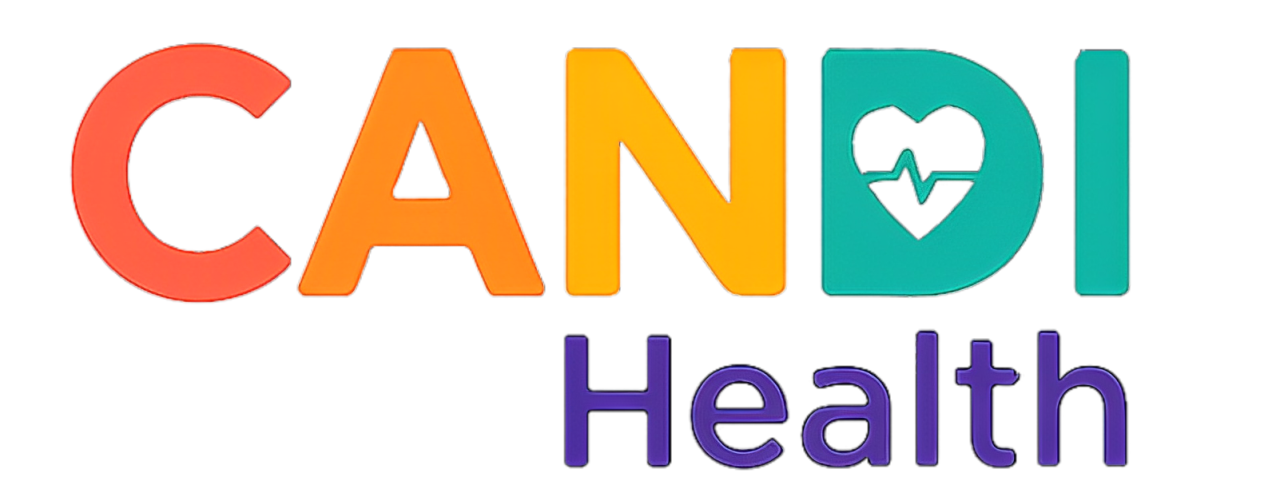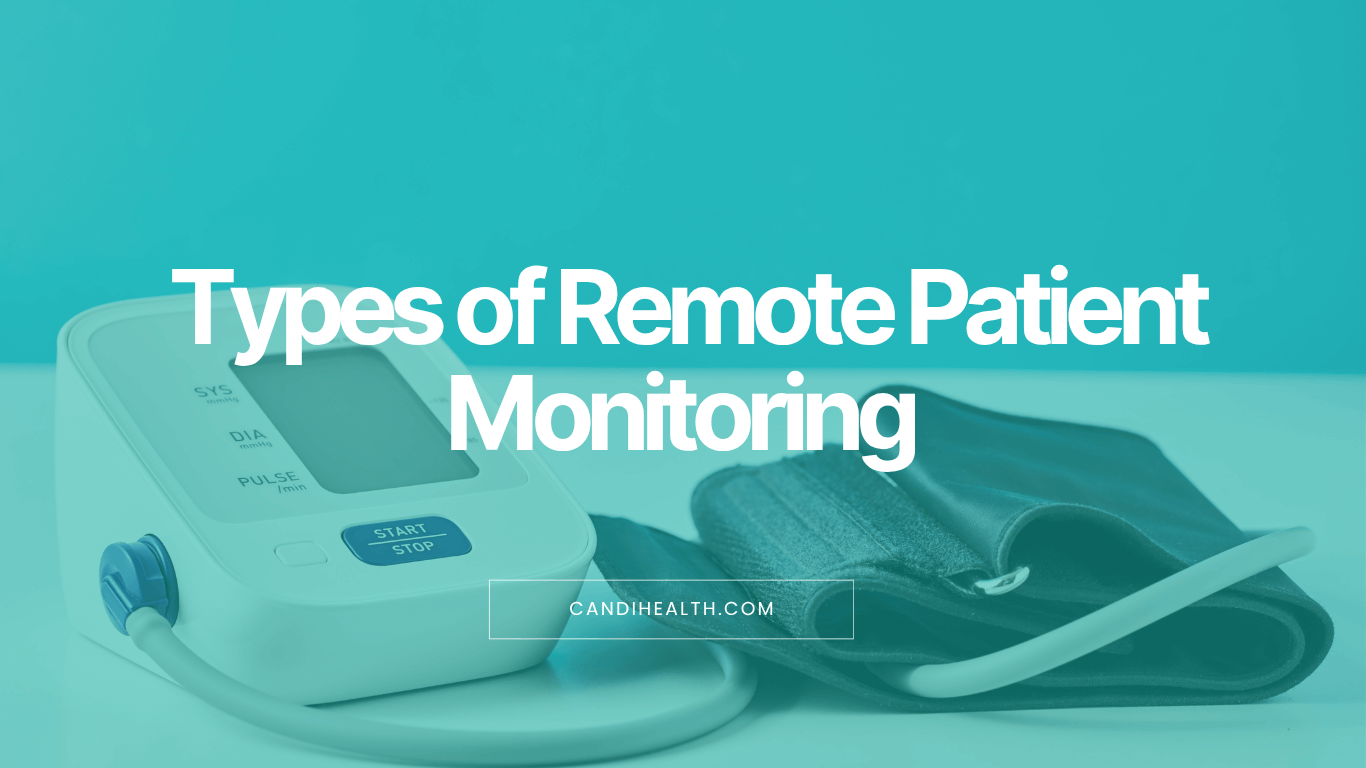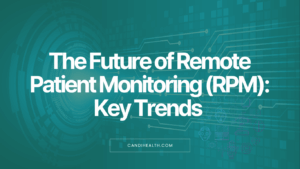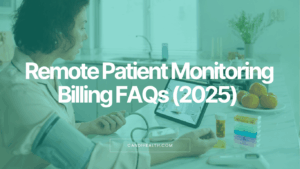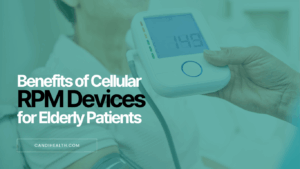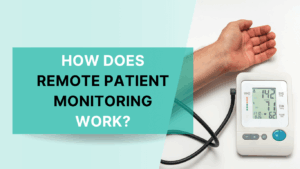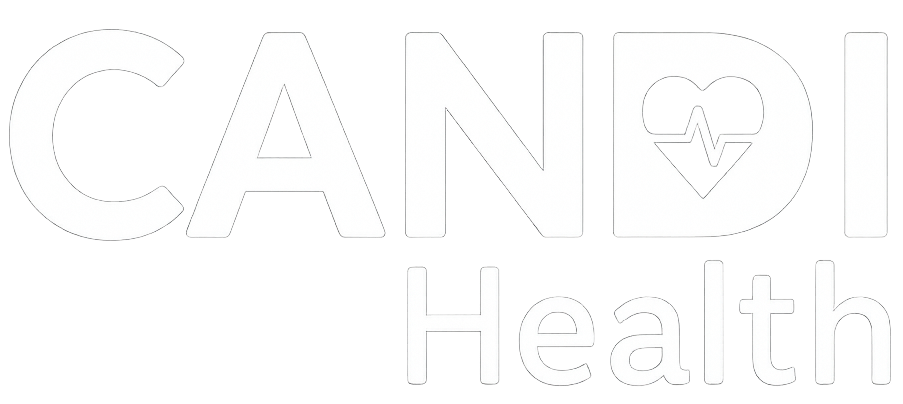Across the U.S., many clinics are using RPM to manage chronic diseases, reduce hospital visits, and give patients real-time care. In fact, Medicare spending on RPM grew from $6.8 million in 2019 to over $190 million in 2023, showing how fast it’s becoming a key part of modern care.
Behind this growth are different types of RPM devices, from blood pressure cuffs to glucose monitors, each designed to track specific health needs. These devices help doctors spot problems early and keep patients healthier from home.
Let’s explore the main types of remote patient monitoring and how each one supports better care and outcomes.
What Is Remote Patient Monitoring?
Remote Patient Monitoring (RPM) is a way for doctors to track a patient’s health outside the clinic. It uses connected devices to collect data from patients at home. That data is sent securely to the care team, who can review it and step in if something looks off.
Think of it as a bridge between clinic visits. Instead of waiting for symptoms to get worse, RPM helps doctors see how patients are doing every day. This leads to early detection, faster response, and better control of chronic conditions such as hypertension, diabetes, and heart disease.
Major Types of Remote Patient Monitoring
Remote patient monitoring isn’t one single tool. It includes different types of devices designed to track specific health data. Here are the main types of remote patient monitoring used in U.S. clinics today:
- Blood pressure monitoring
- Blood glucose monitoring
- Weight and body composition monitoring
- Oxygen saturation (SpO2) monitoring
- Temperature and infection monitoring
- Multi-parameter monitoring systems
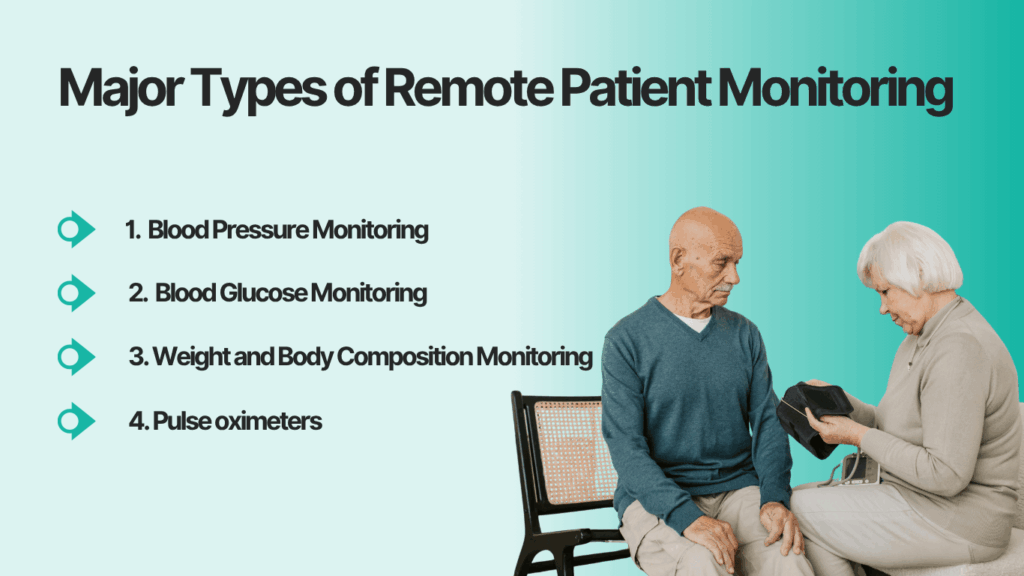
Here is a breakdown of each.
1. Blood Pressure Monitoring
This is one of the most common types of RPM. Connected blood pressure cuffs measure a patient’s readings from home and send the data directly to their doctor.
It’s especially useful for managing hypertension and heart disease. If readings rise or fall outside the safe range, the care team can reach out quickly to adjust treatment or schedule a follow-up.
Example: Cellular blood pressure monitors like those used in CandiHealth’s RPM program work without Wi-Fi, making them ideal for patients in rural areas.
2. Blood Glucose Monitoring
Used mainly for patients with diabetes, glucose monitoring devices track blood sugar levels throughout the day.
Continuous Glucose Monitors (CGMs) automatically send readings to the clinic, helping doctors see trends and spot risks early. This helps patients keep their levels steady and avoid dangerous spikes or drops.
3. Weight and Body Composition Monitoring
Smart weight scales can detect small changes in a patient’s weight that might signal health issues, especially for people with heart failure or obesity. A sudden increase in weight could mean fluid retention, a common sign of worsening heart function.
Regular monitoring helps prevent emergency visits and supports better long-term care.
4. Oxygen Saturation (SpO₂) Monitoring
Pulse oximeters measure the amount of oxygen in the blood. These devices are crucial for patients with respiratory diseases like COPD, asthma, or post-COVID recovery. If oxygen levels drop, alerts can be sent to the care team right away so they can act before symptoms get severe.
5. Temperature and Infection Monitoring
Smart thermometers or skin patches can track a patient’s temperature around the clock.
This is especially useful after surgery or during infection recovery. Even a small rise in temperature can signal an infection, helping care teams respond early and prevent complications.
6. Multi-Parameter Monitoring Systems
Some patients, especially those with multiple chronic conditions, need more than one type of monitoring. Multi-parameter RPM devices combine several features, such as blood pressure, oxygen, temperature, and heart rate tracking into one system.
These are often used by primary care and chronic care clinics across the U.S. to simplify patient management.
Benefits of Using Different RPM Types
Research shows that combining different RPM tools is helpful in chronic disease management. Here are the key benefits, now supported by data:
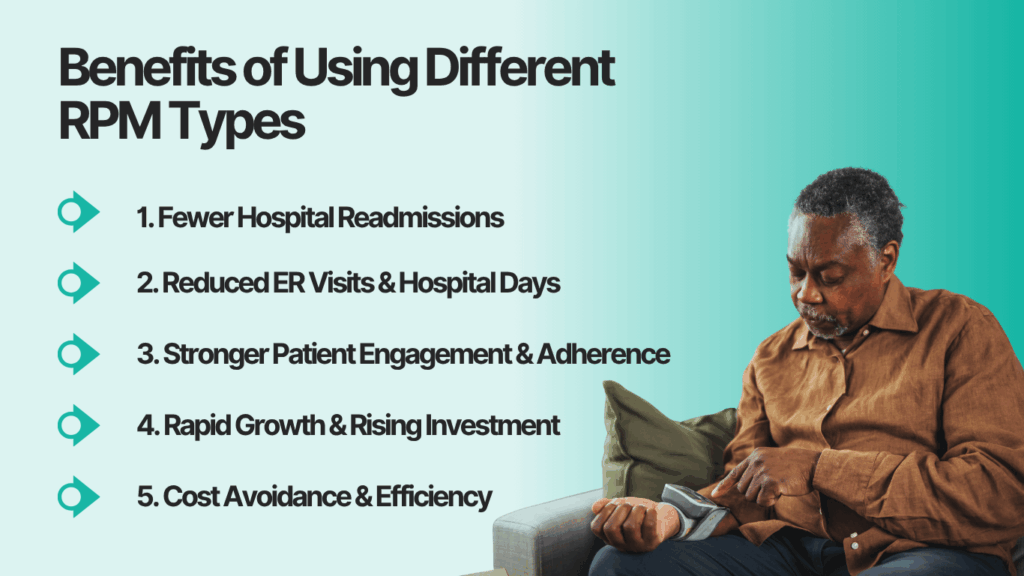
1. Fewer Hospital Readmissions
RPM programs have been shown to reduce hospital readmissions significantly. For example, a KLAS report found a 38% drop in readmissions associated with RPM use. (Connect America).
An Arizona cardiology practice reported a 50% reduction in 30-day readmissions for heart patients using RPM. At Lee Health (Florida), their broad RPM implementation cut overall 30-day readmission rates by 50%. (Healthcare IT News)
2. Reduced ER Visits & Hospital Days:
In one home-monitoring study, average hospitalizations plunged from 0.45 to 0.19 at 3 months, and total hospital days also dropped. (PMC) A systematic review of RPM interventions showed lower hospital admission, shorter lengths of stay, and fewer outpatient visits versus control groups.
3. Stronger Patient Engagement & Adherence
Mayo Clinic data shows 72.5% compliance with care plan tasks among RPM patients, with a low readmission rate (9.4% within 30 days).
RPM tools often encourage patients to take more control over their condition, checking vitals daily, seeing their own trends, and understanding when to reach out. PMC
4. Rapid Growth & Rising Investment
Between 2019 and 2023, RPM use in U.S. primary care jumped 3,035%, with payments rising from about $4.3 million to $118 million. (PMC). In 2023, traditional Medicare payments for RPM totaled $194.5 million, up from $6.8 million in 2019. Over half of RPM spending in Medicare is for hypertension (57%), followed by diabetes (13%).
5. Cost Avoidance & Efficiency
Because hospital stays are expensive, reducing readmissions yields direct cost savings. For example, a 3-day hospital stay can cost ~$30,000; cutting readmissions by 38% significantly reduces those costs. (Connect America). RPM can also lower the burden of in-person visits and better allocate clinician time.
Choosing the Right Type of Remote Patient Monitoring
Not every clinic needs the same kind of RPM setup. The right mix of devices depends on your patient base, the conditions you manage most, and how you plan to use the data.
Here’s a quick guide to help you choose the right type of remote patient monitoring for your clinic:
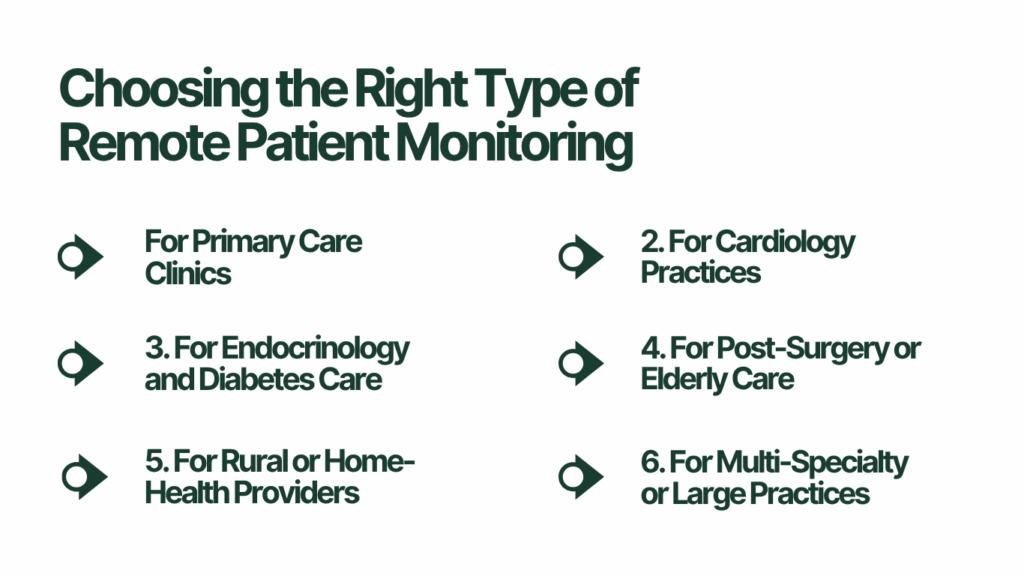
1. For Primary Care Clinics
Primary care providers see a wide range of patients, so they often start with blood pressure, glucose, and oxygen saturation monitoring. These three cover the most common chronic conditions , hypertension, diabetes, and respiratory diseases, which together make up the bulk of the U.S. Medicare RPM use.
Tip: Start with one or two device types and expand as patients and staff get comfortable with the process.
2. For Cardiology Practices
Cardiology-focused clinics benefit most from ECG monitoring, blood pressure tracking, and connected weight scales. These devices help track heart rhythm, blood flow, and fluid changes — all key indicators of heart health. Research shows that combining BP and weight monitoring in heart failure programs can cut readmission rates by up to 50%.
3. For Endocrinology and Diabetes Care
For endocrinologists or diabetes educators, blood glucose monitoring is the top priority.
Adding weight tracking and medication adherence monitoring makes the program stronger, helping patients stay consistent with their treatment and lifestyle changes.
A study published by the American Diabetes Association found that RPM-based glucose monitoring improved HbA1c control by 0.6% on average, compared to traditional follow-ups.
4. For Post-Surgery or Elderly Care
Older adults and post-surgical patients benefit from temperature, SpO₂, and multi-parameter monitoring systems. These tools catch early signs of infection or recovery issues and alert care teams immediately, which can prevent hospital readmissions or complications.
5. For Rural or Home-Health Providers
Clinics serving remote areas should choose cellular-based RPM devices that work without Wi-Fi. These are easier for patients to use, more reliable in low-connectivity zones, and ideal for seniors who may not use smartphones.
CandiHealth’s cellular blood pressure monitors are built for exactly this — plug-and-play monitoring with automatic data transmission and no tech setup required.
6. For Multi-Specialty or Large Practices
Larger health systems or multi-specialty clinics often use multi-parameter RPM systems that integrate all vitals into one platform. This centralizes patient data, reduces manual tracking, and gives doctors a unified dashboard view.
So, Choosing the right type of RPM is about matching the technology to your patients’ needs, not just adding more devices. Start small, focus on one condition or device type, and grow your program as you see results.
The Future of Remote Patient Monitoring
Across the U.S., RPM is expanding fast. According to recent Medicare data, more than one million patients are now enrolled in remote monitoring programs, and that number grows each month. This growth is fueled by two main trends:
- Value-based care models that reward prevention over hospitalization.
- Simpler, smarter technology that makes RPM easy for both patients and clinics.
In the next few years, we’ll see RPM play a bigger role in preventive medicine, mental health tracking, and even AI-driven prediction of health risks.Clinics that adopt flexible, scalable systems today will be ready to meet these changes tomorrow.
Platforms like CandiHealth are built around that idea, combining cellular-based devices, real-time dashboards, and flat-fee pricing to make RPM simple, affordable, and effective for every clinic.
Ready to launch your RPM program? Get started with CandiHealth today.
Frequently Asked Questions (FAQs)
1. What are remote patient monitoring systems?
Remote patient monitoring (RPM) systems are tools that track a patient’s vital signs and health data outside the clinic. They use connected devices such as blood pressure cuffs, glucose monitors, and oxygen sensors to send information directly to doctors. This helps care teams monitor patients in real time and act early if something changes.
2. How many types of patient monitoring systems are there?
There are many types of patient monitoring systems, but the main categories include:
- Blood pressure monitoring
- Blood glucose monitoring
- Weight tracking
- Heart rate and ECG monitoring
- Temperature monitoring
- Medication adherence monitoring
Each type focuses on a specific aspect of patient health and can be combined for full-spectrum care.
3. What is the 7-parameter patient monitor?
A 7-parameter patient monitor is a hospital-grade device that measures seven key health parameters at once, typically ECG, heart rate, blood pressure, SpO₂, temperature, respiratory rate, and pulse. While these monitors are mainly used in hospitals, remote versions are now being used in RPM programs for continuous home tracking.
4. Which tools are used for remote monitoring of patients?
Common tools used for remote patient monitoring include:
- Cellular blood pressure cuffs
- Continuous glucose monitors (CGMs)
- Pulse oximeters for oxygen tracking
- Smart weight scales
- Wearable ECG devices
- Smart pill bottles or reminder systems
